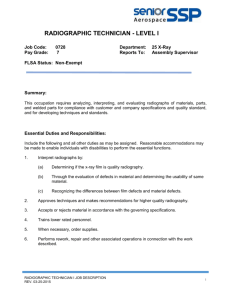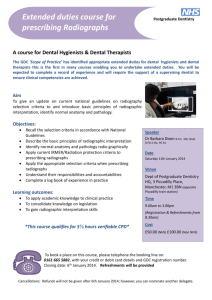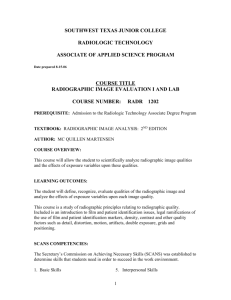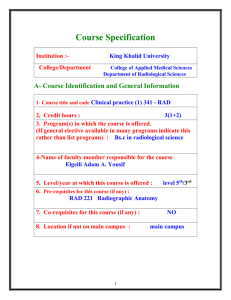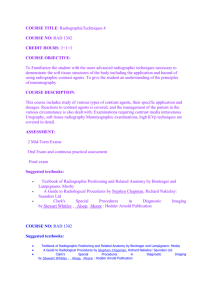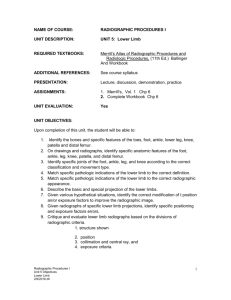DHY164 - Des Moines Area Community College
advertisement
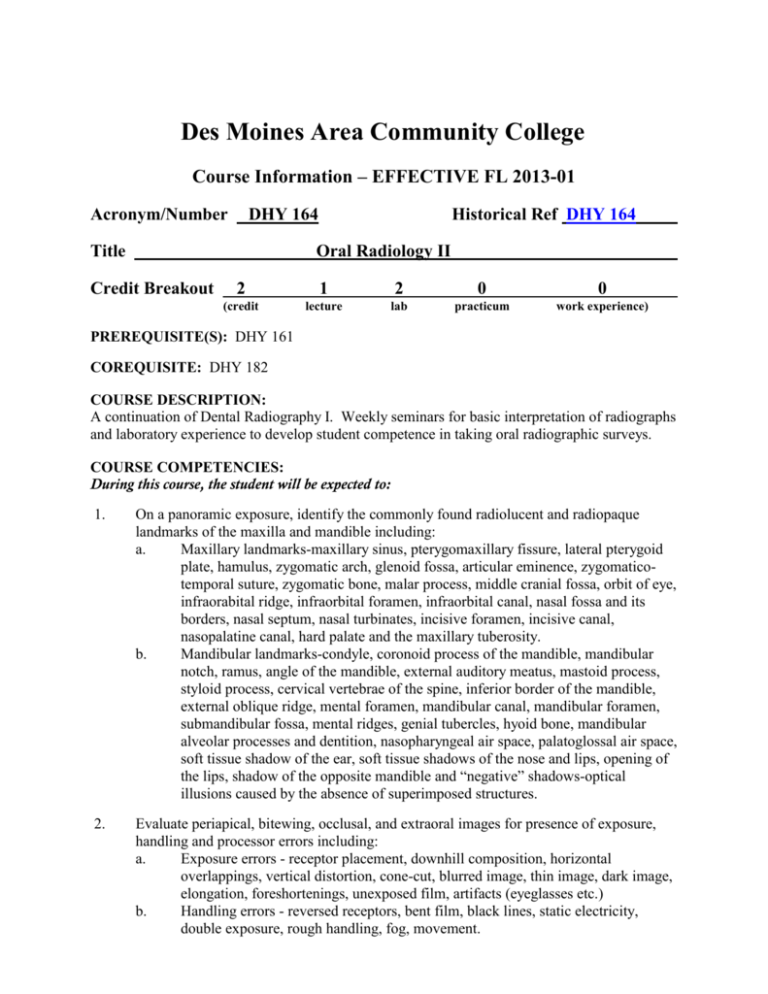
Des Moines Area Community College Course Information – EFFECTIVE FL 2013-01 Acronym/Number DHY 164 Title Historical Ref DHY 164 Oral Radiology II Credit Breakout 2 1 2 0 0 (credit lecture lab practicum work experience) PREREQUISITE(S): DHY 161 COREQUISITE: DHY 182 COURSE DESCRIPTION: A continuation of Dental Radiography I. Weekly seminars for basic interpretation of radiographs and laboratory experience to develop student competence in taking oral radiographic surveys. COURSE COMPETENCIES: During this course, the student will be expected to: 1. On a panoramic exposure, identify the commonly found radiolucent and radiopaque landmarks of the maxilla and mandible including: a. Maxillary landmarks-maxillary sinus, pterygomaxillary fissure, lateral pterygoid plate, hamulus, zygomatic arch, glenoid fossa, articular eminence, zygomaticotemporal suture, zygomatic bone, malar process, middle cranial fossa, orbit of eye, infraorabital ridge, infraorbital foramen, infraorbital canal, nasal fossa and its borders, nasal septum, nasal turbinates, incisive foramen, incisive canal, nasopalatine canal, hard palate and the maxillary tuberosity. b. Mandibular landmarks-condyle, coronoid process of the mandible, mandibular notch, ramus, angle of the mandible, external auditory meatus, mastoid process, styloid process, cervical vertebrae of the spine, inferior border of the mandible, external oblique ridge, mental foramen, mandibular canal, mandibular foramen, submandibular fossa, mental ridges, genial tubercles, hyoid bone, mandibular alveolar processes and dentition, nasopharyngeal air space, palatoglossal air space, soft tissue shadow of the ear, soft tissue shadows of the nose and lips, opening of the lips, shadow of the opposite mandible and “negative” shadows-optical illusions caused by the absence of superimposed structures. 2. Evaluate periapical, bitewing, occlusal, and extraoral images for presence of exposure, handling and processor errors including: a. Exposure errors - receptor placement, downhill composition, horizontal overlappings, vertical distortion, cone-cut, blurred image, thin image, dark image, elongation, foreshortenings, unexposed film, artifacts (eyeglasses etc.) b. Handling errors - reversed receptors, bent film, black lines, static electricity, double exposure, rough handling, fog, movement. DHY 164 c. Processing errors - underdeveloped, overdeveloped, partial image, incomplete immersion in developer, incomplete immersion in fixer, exposure to white light, receptors stuck to each other, scratches. 3. Relate methods of prevention or correction of previously identified exposure, handling and processing errors. 4. Demonstrate proficiency in the fundamental use of digital radiography. 4.1 Review advantages and disadvantages of digital imaging systems. 4.2 Describe the two types of radiographic digital imaging. 4.3 discuss the advantages and disadvantages of the different types of receptors. 4.4 Describe and demonstrate infection control procedures that should be used with digital receptors. 4.5 discuss legal issues that surround the use of digital imaging. 4.6 Discuss the application of the DICOM standard to imaging in dentistry. 4.7 describe and utilize image processing techniques. 5. Describe proper patient positioning and head alignment and rationale for use for the following extra oral radiographic exposures including: a. Lateral oblique exposure b. Posteroanterior c. Water's d. Reverse-Towne e. Submentovertex f. Lateral cephalometric g. Transcranial (TMJ) h. Panoramic 6. Demonstrate steps in operation of the Orthoratix 8500 machine for exposing panoramic, and temporo-mandibular joint exposures. 6.1 Check the readiness of your machine for the chosen exposure. 6.2 Ready the patient. 6.3 Position the patient. a. Adjustments for children b. Adjustments for edentulous patients 6.4 Expose radiograph. 6.5 Recall the rationale for choosing screened or non screened film. 6.6 Relate steps in loading, cleaning and caring for the cassette and screens. 7. Contrast conventional radiographic techniques with tomography, digital radiography, and magnetic resonance imaging. 7.1 Describe the following imaging methods including energy sources, receptors and common applications: a. tomography b. arthrography c. sialography d. M.R.I. DHY 164 7.2 7.3 7.4 7.5 7.6 e. Stereoscopy f. Scanography g. Ultrasonography h. Electronic thermography Relate the contraindications for use of contrast agents in arthrography and sialography. List indications for use of bone scanning in dentistry. Contrast radiation exposure to a patient in conventional radiography and nuclear medicine. Describe advantages of C.T. over conventional radiographic imaging. Evaluate the use of intraoral source radiography in dentistry. 8. Recall radiographic manifestations of pathologic conditions of the jaws including most common benign neoplasms and malignancies. 9. Employ a systematic approach in radiographic interpretation. 9.1 Incorporate case history, clinical examination and any existing films. 9.2 Use an appropriate viewing environment. 9.3 Discriminate normal versus abnormal. a. list observations b. use specific vocabulary to describe site, size, shape, symmetry, borders and associations c. review broad classifications of disease d. recall radiographic patterns of jaw lesions 10. Identify dental caries on a radiograph. 10.1 State the most accurate radiologic techniques for detecting caries on radiographs. 10.2 Recognize the following types of caries on radiographs: a. interproximal b. occlusal c. buccal-lingual d. root (cemental) e. recurrent f. rampant g. pulp exposure 10.3 Detail the radiographic classifications of caries. a. incipient b. moderate c. severe d. advanced 10.4 Recall the manner in which any of the following affects caries interpretation a. contrast scale b. exposure time c. film processing d. angulation e. restorative materials f. cervical burnout g. overlapping teeth DHY 164 11. Distinguish the radiographic features of periodontal disease. 11.1 Discuss the importance of the clinical and radiographic examinations in the diagnosis of periodontal disease. 11.2 Discuss the limitations of radiographs in the detection of periodontal disease. 11.3 Describe the type of radiographs that should be used to document periodontal disease and the preferred exposure technique. 11.4 State the differences among the bone loss classifications and recognize their radiographic appearances. a. localized b. generalized c. mild d. moderate e. severe f. vertical g. horizontal 11.5 Identify clear-cut radiographic evidence of bone loss. a. osseous defects b. interproximal craters c. triangulation d. interproximal hemisepta e. bifurcation involvement f. proximal intrabony defect 12. Describe radiographic and clinical signs and symptoms of infections of periapical tissues. 13. List common dental anomalies and their distinctive clinical and radiographic features including: a. supernumary teeth b. fusion c. gemination d. concrescence e. developmentally missing teeth f. enamel pearl g. microdontia h. macrodontia i. transposition j. taurodontism k. Turner's tooth l. dilaceration m. dentin dysplasia n. amelogenesis imperfecta o. dentinogenesis imperfects p. dens evaginatus q. dens invaginatus, dens in dente r. odontodysplasia s. congenital syphilis DHY 164 14. Recognize radiographic features of regressive changes in the dentition including: a. attrition b. abrasion c. abfraction d. erosion e. resorption f. secondary dentin formation g. pulp stones h. pulpal sclerosis i. cementicles j. hypercementosis k. bone resorption 15. State radiographic aspects of common traumas to the teeth and facial structures and recall methods of management of the traumas. 16. Practice all principles of radiation safety applicable to actual exposure of radiographs. 16.1 Place protective apron on patient. 16.2 Stand in most protected area available during exposure, and ensure that others are out of exposure area 16.3 Use receptor holder - do not hold receptors. 16.4 Use properly stored film of fastest speed available or digital receptors. 16.5 Take the absolute minimum number of images which will provide a survey that meets the criteria, taking no more than four retakes in a series of 16 P.A.'s & 4 B.W.'s 16.6 Use any other safety procedures necessary (e.g., film badges, digital receptors, etc.) 17. Produce radiographic exposures which meet identified criteria of diagnostic quality. 17.1 Recognize the identified criteria: a. Images show diagnostically useful contrast and detail (e.g., a defined difference in density between adjacent areas or tissues and sharp, distinct images) b. Image is accurately reproduced c. Entire receptor is exposed d. Interproximal surfaces are clearly visible in at least one projection without excessive separation of buccal and lingual cusps (when anatomically possible). At least one-eighth inch of crestal bone must be visible interproximally. e. Posterior aspects of mandibular and maxillary tooth-bearing surfaces are completely visible: a. Maxilla: upward curve of the tuberosity is visible b. Mandible: at least one inch distal to the upslope of the ramus is visible f. Apices of all teeth are visible in at least one projection with at least oneeighth inch of alveolar bone surrounding them DHY 164 17.2 Demonstrate the ability to produce a diagnostically acceptable panoramic radiograph. 18. Determine the appropriate radiographic exposure according to the needs of the operator and the characteristics of the patient. 18.1 Use the exposure technique which minimizes patient discomfort and anxiety. 18.2 Relate receptor and tube-head placement for disto-oblique exposure techniques. 18.3 Recall methods used to localize an object in the oral cavity. 18.4 Recognize appropriate use of film duplicating. 18.5 List steps in film duplicating. 19. Accept responsibility for decisions regarding need for exposure, interpretation and utilization of radiographs. 19.1 Precede decisions regarding need for radiographs with a review of the health history. 19.2 Perform clinical examination prior to exposing any radiographs. 19.3 Adhere to accepted guidelines for prescribing radiographs. 19.4 Review all available radiographs of each patient for interpretation of presence or absence of disease. 19.5 Record radiographic findings in the examination chart. DHY 164 COMPETENCIES REVIEWED AND APPROVED BY: Deborah Penney DATE: March 2012 FACULTY: 1. 2. 3. COMPETENCIES REVIEWED AND APPROVED BY: Lori Brown DATE: November 2011 FACULTY: 1. Lori Brown 2. 3. COMPETENCIES REVIEWED AND APPROVED BY: Lori Brown DATE: March 2007 FACULTY: 1. Lori Brown 2. 3. 4. 5. 6. Effective date August 2012 Originated by: Marilyn Corwin R.D.H., B.A. Campus: extension: Revision(s): 11/11; 3/12; A B C U N W OC 6309 1/03; 1/04; 10/04; 8/05; 8/06; 3/07;
